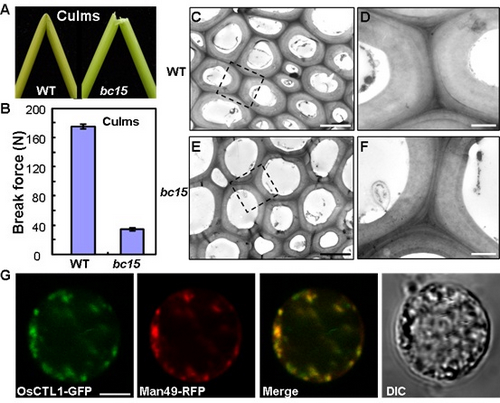-
A Chitinse-Like Protein BC15 is Required for Cellulose Biosynthesis in Rice
TIME: 21 Aug 2012The cell wall structure is complex and contains various components such as polysaccharides, lignin and proteins and the cell wall plays a key role in providing mechanical support for plants. Researches about rice cell wall are of great significance for the improvement of lodging and other agronomic traits.
Plant chitinases, a class of glycosyl hydrolases (GHs), participate in various processes of normal plant growth and development, including cell wall metabolism and disease resistance. However, no rice chitinase has been characterized at the genetic level until now.
Scientists in Dr. Zhen Zhu and Yihua Zhu’s group from the Institute of Genetics and Developmental Biology, the Chinese Academy of Sciences reported the characterization of a rice brittle culm mutant (bc15) and its corresponding gene. Map-based cloning showed that BC15 encodes a class II chitinase-like protein (OsCTL1).
Mutation of BC15/OsCTL1 causes reduced cellulose content and mechanical strength without obvious alterations in plant growth. Biochemical assays demonstrated that BC15/OsCTL1 is a Golgi-localized type-II membrane protein and lacks classical chitinase activity. The Golgi-localized feature of BC15/OsCTL1 is distinct from that of most reported chitinases, which are apoplastic. Investigation of the global expression profile of wild-type and bc15 plants further suggested a possible mechanism by which BC15/OsCTL1 mediates in cellulose biosynthesis and cell wall remodeling.
Their findings provide previously unreported genetic evidence for the role of rice chitinases in cellulose biosynthesis, which appears different from the roles of its homologs in Arabidopsis.
This work with Dr. Bin Wu, Baocai Zhang and Yan Dai as the first authors has been online published on Plant Physiology (doi:10.1104/pp.112.195529) in August 2012. This research was supported by grants from Chinese Academy of Sciences, Ministry of Science and Technology, Ministry of Agriculture of China, and National Natural Science Foundation of China.
AUTHOR CONTACT:
Zhen Zhu, Ph.D.
Institute of Genetics and Developmental Biology, Chinese Academy of Sciences, Beijing, China.
E-mail: zzhu@genetics.ac.cn

(Image by Bin Wu et al.)
Figure Mutation in Golgi-located BC15 results in secondary wall defects exhibited by brittleness phenotypes. A, The mutant internode is easily broken. B, Triple measurements of the break force of internodes. C to F, Transmission electron micrographs of the sclerenchyma cell walls of the wild type (C) and bc15 (E). D and F are enlargements of the boxed areas in C and F, respectively. G, A rice protoplast cell coexpressing BC15/OsCTL1-GFP, a Golgi marker (Man49-RFP), indicating BC15/OsCTL1 is Golgi-localized. Bars = 5 mm (C and E), 1 mm in (D and F) and 5 μm (G).
 CAS
CAS
 中文
中文




.png)
